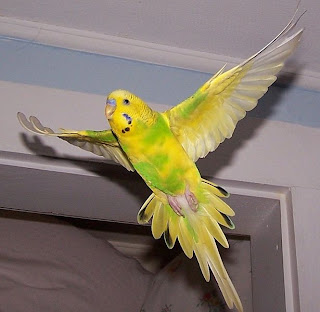Aviculture is the practice of safeguarding of breeding birds and the culture that forms around it. Aviculture is generally focused on not only the raising and breeding of birds, but also on preserving avian habitat, and public awareness campaigns.


The budgerigar has been bred in captivity since the 1850s. Breeders have worked over the decades to produce a wide range of colour, pattern, and feather mutations, such as albino, blue, cinnamon-ino (aka lacewinged), clearwinged, crested, dark, grey winged, opaline, pieds, spangled, dilute (suffused), and violet.
Standard-type budgerigars are about twice as large as their wild-type counterparts. Their overall larger sizes and puffier head feathers give them a boldly exaggerated look. The eyes and beak can be almost totally obscured by these fluffy head feathers. English budgerigars are typically more expensive than wild-type birds and typically have a shorter life span of 7–9 years. Breeders of English Budgerigars often exhibit their birds at animal shows. Most captive budgerigars in the pet trade are similar in size and body conformation to wild budgerigars.
Tame budgerigars can be taught to speak, whistle tunes, and play with humans. Both males and females sing and can learn to mimic sounds and words and do simple tricks. Both singing and mimicry are more pronounced and better perfected in males. Females rarely learn to mimic more than a dozen words. Males can easily acquire vocabularies ranging between a few dozen to a hundred words. Pet males, especially those kept alone, are generally the best speakers.
In captivity, budgerigars live an average of five to eight years, but life-spans of 15–20 years have been reported. The lifespan depends on breed, lineage, and health, being highly influenced by exercise and diet.
Budgerigars will chew on anything they can find to keep their beaks trimmed. Mineral blocks (ideally enriched with iodine), cuttlebone, and soft wooden pieces are suitable items for this activity.
Budgerigars have been shown to cause "bird fancier's lung" in sensitive people, a type of hypersensitivity pneumonitis.


The budgerigar has been bred in captivity since the 1850s. Breeders have worked over the decades to produce a wide range of colour, pattern, and feather mutations, such as albino, blue, cinnamon-ino (aka lacewinged), clearwinged, crested, dark, grey winged, opaline, pieds, spangled, dilute (suffused), and violet.
Standard-type budgerigars are about twice as large as their wild-type counterparts. Their overall larger sizes and puffier head feathers give them a boldly exaggerated look. The eyes and beak can be almost totally obscured by these fluffy head feathers. English budgerigars are typically more expensive than wild-type birds and typically have a shorter life span of 7–9 years. Breeders of English Budgerigars often exhibit their birds at animal shows. Most captive budgerigars in the pet trade are similar in size and body conformation to wild budgerigars.
Budgerigars are social animals and require stimulation in the shape of toys and interaction with humans, as well as with other budgerigars. A common behavior is chewing material such as wood, especially for females. When a budgerigar feels threatened, it will try to perch as high as possible and may make itself appear thin by bringing its feathers close against its body.
Tame budgerigars can be taught to speak, whistle tunes, and play with humans. Both males and females sing and can learn to mimic sounds and words and do simple tricks. Both singing and mimicry are more pronounced and better perfected in males. Females rarely learn to mimic more than a dozen words. Males can easily acquire vocabularies ranging between a few dozen to a hundred words. Pet males, especially those kept alone, are generally the best speakers.
In captivity, budgerigars live an average of five to eight years, but life-spans of 15–20 years have been reported. The lifespan depends on breed, lineage, and health, being highly influenced by exercise and diet.
Budgerigars will chew on anything they can find to keep their beaks trimmed. Mineral blocks (ideally enriched with iodine), cuttlebone, and soft wooden pieces are suitable items for this activity.
Budgerigars have been shown to cause "bird fancier's lung" in sensitive people, a type of hypersensitivity pneumonitis.

إرسال تعليق